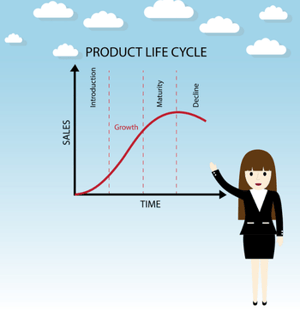Predict Revenue Growth with Product and Service Life Cycles
 Did you know that almost every business follows a typical life cycle with regard to what it chooses to sell? The life cycles of products and services illustrate their growing or shrinking market positions, and are usually determined by how long they remain in demand.
Did you know that almost every business follows a typical life cycle with regard to what it chooses to sell? The life cycles of products and services illustrate their growing or shrinking market positions, and are usually determined by how long they remain in demand.
In most cases, the sales and profit volumes associated with various life cycle positions follow a predictable path. So, understanding which phase of the product or service life cycle your business is in can help you predict revenue growth. And that’s important. Because any time your business is able to forecast its revenue more accurately, you stand to benefit from improved decision making.
Knowing whether your product or service is on its way up or on its way down in terms of profitability not only contributes to the success of your revenue forecasts, it lets you manage your marketing plans, hiring practices, and cash flow more effectively.
Examining the Four Product and Service Life Cycle Stages
After the initial development phase, most products and services follow four defined stages: launch, growth, maturity, and decline. Determining which of these phases your product or service currently occupies can help you refine your marketing approach and ensure you achieve optimal performance. So, let’s take a closer look at the four life cycle stages, and what they might mean for your business.
Launch Stage
- Profits are typically low when a product or service is first launched due to the costs associated with development and marketing
- Your business may choose to either price high – in an effort to recoup initial costs more quickly – or price low to gain clients faster
- It’s important to monitor customer feedback during this stage so you can adjust your new product or service accordingly
- This can also be a good time to experiment with different versions of your offering to see which holds the strongest client appeal
Revenue growth prediction take-away: While your product or service is active in the market during this stage, sales may be slow to materialize, and your overall profit will probably be negative.
Growth Stage
- During the growth stage, you can expect sales of your product or service to increase as customer demand continues to build
- Both your profit and your cash flow should be growing, with profits eventually reaching a peak
- It’s especially important to keep tabs on - and stay ahead of - your competition at this time
- Many companies choose to reinvest some of their profits into further improving their product or service during this stage
Revenue growth prediction take-away: Your product or service is likely to generate its greatest profits during this phase of its life cycle.
Maturity Stage
- Once your product or service reaches maturity, sales may or may not begin to level off, but your profit is likely to decrease as prices must often be lowered to keep your offering competitive
- Research performed during this stage is invaluable for determining market trends and discovering ways to differentiate your product or service
- It’s important to explore new markets and opportunities, and fresh products or services now to help offset the looming decline stage
Revenue growth prediction take-away: Sales of your product or service may continue to grow during this stage, but your profit will likely decline.
Decline Stage
- During the decline stage, lowering prices is no longer sufficient to keep sales of your product or service from dropping off, and your profits are likely to be extremely low
- This can be a good time to “re-launch” your product with a new selling feature or benefit, or by way of a new marketing strategy
- Ultimately, you will eventually reach a point of no return where discontinuing your service is the only way to keep losses from undermining your cash flow
Revenue growth prediction take-away: Both sales and profits generated by your product or service gradually decline below meaningful levels during this stage.
The main thing to remember about typical product and service life cycles is that they’re extremely fluid. In order to make the most of your current market position – and of where your product or service is eventually headed - your business needs to exhibit that same level of agility.
Keep a close watch on your product or service’s life cycle stages, solicit regular feedback from customers, and monitor overall industry and market conditions. By doing so, you’ll be better positioned to adjust your revenue, marketing, and business strategies accordingly.
Photo Credit: Canva


Comments